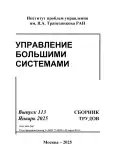Detecting point anomalies in energy consumption data using unsupervised machine learning methods
- Authors: Maryasin O.Y.1, Tihomirov L.I.1
-
Affiliations:
- Yaroslavl State Technical University
- Issue: No 113 (2025)
- Pages: 232-272
- Section: Control of social-economic systems
- URL: https://journal-vniispk.ru/1819-2440/article/view/289714
- ID: 289714
Cite item
Full Text
Abstract
About the authors
Oleg Yur'evich Maryasin
Yaroslavl State Technical University
Email: maryasin2003@list.ru
Yaroslavl
Leonid Igorevich Tihomirov
Yaroslavl State Technical University
Email: lenusscik@yandex.ru
Yaroslavl
References
- МАРЬЯСИН О.Ю., ЛУКАШОВ А.И., ТИХОМИРОВ Л.И.Обнаружение аномальных отклонений от типового профи-ля энергопотребления // Математические методы в техникеи технологиях. – 2022. – №8. – P. 108–113.
- О внесении изменений в некоторые акты ПравительстваРоссийской Федерации по вопросам совершенствования ор-ганизации учета электрической энергии. ПостановлениеПравительства Российской Федерации от 29 июня 2020 г. –№950. – 32 с.
- ALMARDENY Y., BOUJNAH N., CLEARY F. A NovelOutlier Detection Method for Multivariate Data // IEEE Trans.on Knowledge and Data Engineering. – Vol. 32. – 2020. –P. 1–13.
- BURGESS C.P., HIGGINS I., PAL A. et al. Understandingdisentangling in β-VAE // arXiv:1804.03599v1. – 2018. –P. 1–11.
- CHANDOLA V., BANERJEE A., KUMAR V. AnomalyDetection: A Survey // ACM Computing Surveys. – 2009. –Vol. 41. – P. 1–58.
- DUMOULIN V., BELGHAZI I., POOLE B. et al. Adversariallylearned inference // arXiv:1606.00704v3. – 2017. – P. 1–18.
- GitHub – KulikDM/pythresh: Outlier Detection Thresholding. –URL: https://github.com/KulikDM/pythresh (дата обращения:30.08.2024).
- GitHub – yzhao062/pyod: A Python Library for Outlier andAnomaly Detection, Integrating Classical and Deep LearningTechniques. – URL: https://github.com/yzhao062/pyod (датаобращения: 30.08.2024).
- GOLDSTEIN M., DENGEL A. Histogram-based Outlier Score(HBOS): A fast Unsupervised Anomaly Detection Algorithm //Conference KI-2012. – 2012. – P. 1–6.
- GULATI M., ARJUNAN P. LEAD1.0: A large-scale annotateddataset for energy anomaly detection in commercial buildings //arXiv:2203.17256v1. – 2022. – P. 1–5.
- HABEN S., SINGLETON C., GRINDROD P. Analysis andclustering of residential customers energy behavioral demandusing smart meter data // IEEE Trans. on Smart Grid. – 2016. –Vol. 1. – P. 136–144.
- HIMEUR Y., GHANEM K., ALSALEMI A. et al. Artificialintelligence based anomaly detection of energy consumptionin buildings: A review, current trends and new perspectives //Applied Energy. – 2021. – Vol. 287. – P. 1–26.
- KINGMA D.P., WELLING M. Auto-Encoding VariationalBayes // Int. Conf. on Learning Representations. – 2013. –P. 1–14.
- LI C., LIU H., CHEN C. et al. ALICE: Towards UnderstandingAdversarial Learning for Joint Distribution Matching //arXiv:1709.01215v2. – 2017. – P. 1–22.
- LI K., MA Z., ROBINSON D. et al. Identification of typicalbuilding daily electricity usage profiles using Gaussian mixturemodel-based clustering and hierarchical clustering // AppliedEnergy. – 2018. – Vol. 231. – P. 331–342.
- LI K., YANG R.J., ROBINSON D. et al. An agglomerativehierarchical clustering-based strategy using Shared NearestNeighbours and multiple dissimilarity measures to identifytypical daily electricity usage profiles of university librarybuildings // Energies. – 2019. – Vol. 174. – P. 735–748.
- LINDEMANN B., MASCHLER B., SAHLAB N. et al. Asurvey on anomaly detection for technical systems using LSTMnetworks // Computers in Industry. – 2021. – Vol. 131. – P. 1–11.
- LI S., HAN Y., YAO X. et al. Electricity theft detection inpower grids with deep learning and random forests // Journalof Electrical and Computer Engineering. – 2019. – P. 1–12.
- LIU X., DING Y., TANG H. et al. A data mining-based framework for the identification of daily electricityusage patterns and anomaly detection in building electricityconsumption data // Energy and Buildings. – 2021. – Vol. 231. –P. 1–22.
- LI Z., ZHAO Y., BOTTA N. et al. COPOD: Copula-BasedOutlier Detection // arXiv:2009.09463v1. – 2020. – P. 1–6.
- LI Z., ZHAO Y., HU X. et al. ECOD: UnsupervisedOutlier Detection Using Empirical Cumulative DistributionFunctions // arXiv:2201.00382v3. – 2022. – P. 1–13.
- MARYASIN O.YU., TIHOMIROV L. Analysis of Point andCollective Anomalies in Energy Consumption Data // Int.Russian Automation Conf. (RusAutoCon–2023). – 2023. –P. 431–436.
- PEVNY T. Loda: Lightweight on-line detector of anomalies //Mach Learn. – 2016. – Vol. 102. – P. 275–304.
- RAJABI A., ESKANDARI M., GHADI M.J. et al. Acomparative study of clustering techniques for electrical loadpattern segmentation // Renewable and Sustainable EnergyReviews. – 2020. – Vol. 120. – P. 1–20.
- RASANEN T., KOLEHMAINEN M. Feature-Based Clusteringfor Electricity Use Time Series Data // Int. Conf. on Adaptiveand Natural Computing Algorithms. – 2009. – P. 401–412.
- RUFF L., VANDERMEULEN R.A., GORNITZ N. et al.Deep One-Class Classification // 35th Int. Conf. on MachineLearning. – 2018. – P. 1–10.
- SCHLEGL T., SEEBOCK P., WALDSTEIN S.M. et al.Unsupervised anomaly detection with generative adversarialnetworks to guide marker discovery // Int. Conf. on InformationProcessing in Medical Imaging. – 2017. – P. 146–157.
- SIAL A., SINGH A., MAHANTI A. Detecting anomalousenergy consumption using contextual analysis of smart meterdata // Wireless Networks. – 2019. – P. 1–18.
- Thresholding Outlier Detection Scores with PyThresh. –URL: https://towardsdatascience.com/thresholding-outlier-detection-scores-with-pythresh-f26299d14fa (дата обращения:30.08.2024).
- VERLEYSEN M., FRANCOIS D. The curse of dimensionalityin data mining and time series prediction // Int. Work-Conf. onArtificial Neural Networks. – 2005. – P. 758–770.
- WANG X., ZHAO T., LIU H., HE R. Power consumptionpredicting and anomaly detection based on long short-termmemory neural network // IEEE 4th Int. Conf. on CloudComputing and Big Data Analysis. – 2019. – P. 487–491.
- ZENATI H., ROMAIN M., FOO C.S. et al. AdversariallyLearned Anomaly Detection // arXiv:1812.02288v1. – 2018. –P. 1–11.
Supplementary files










